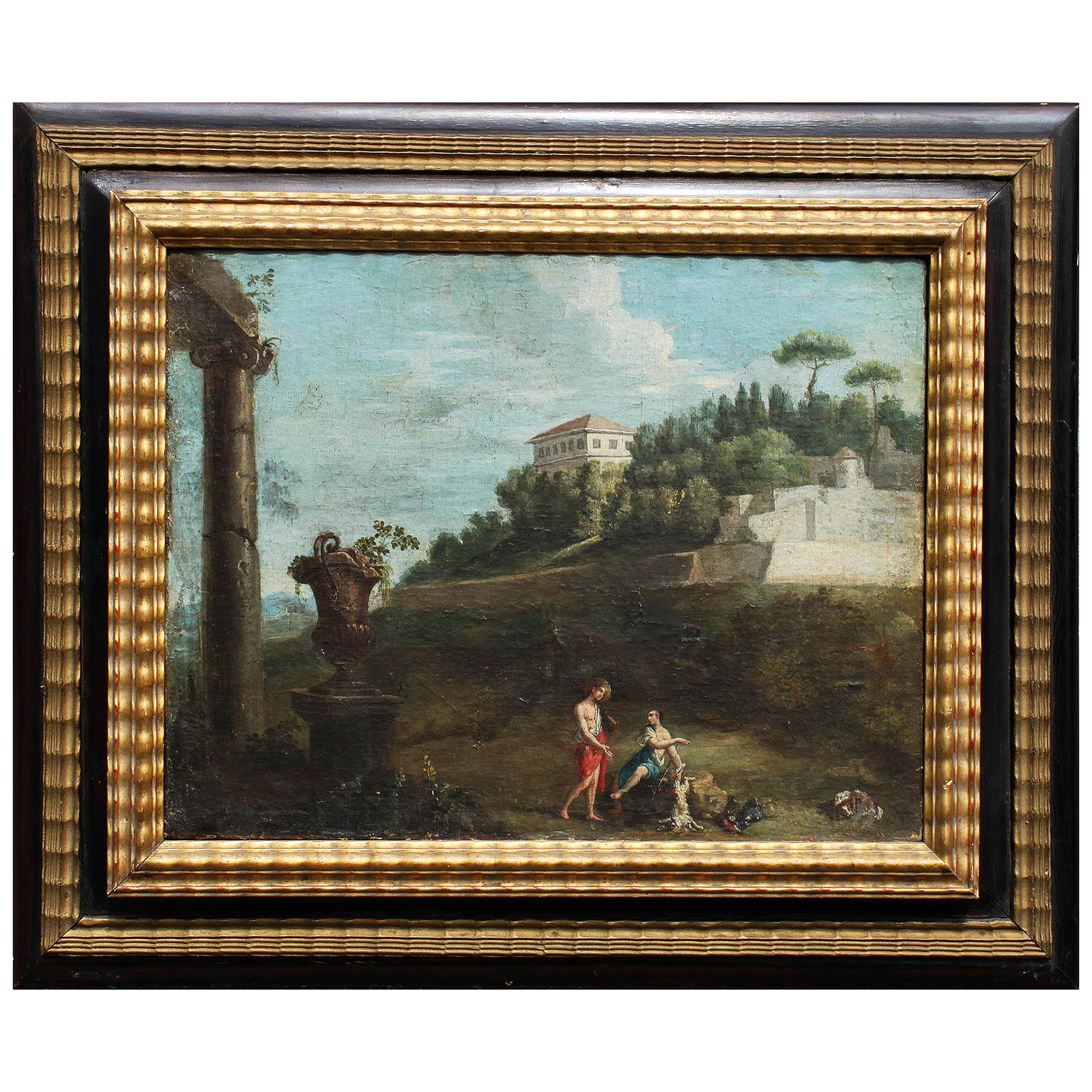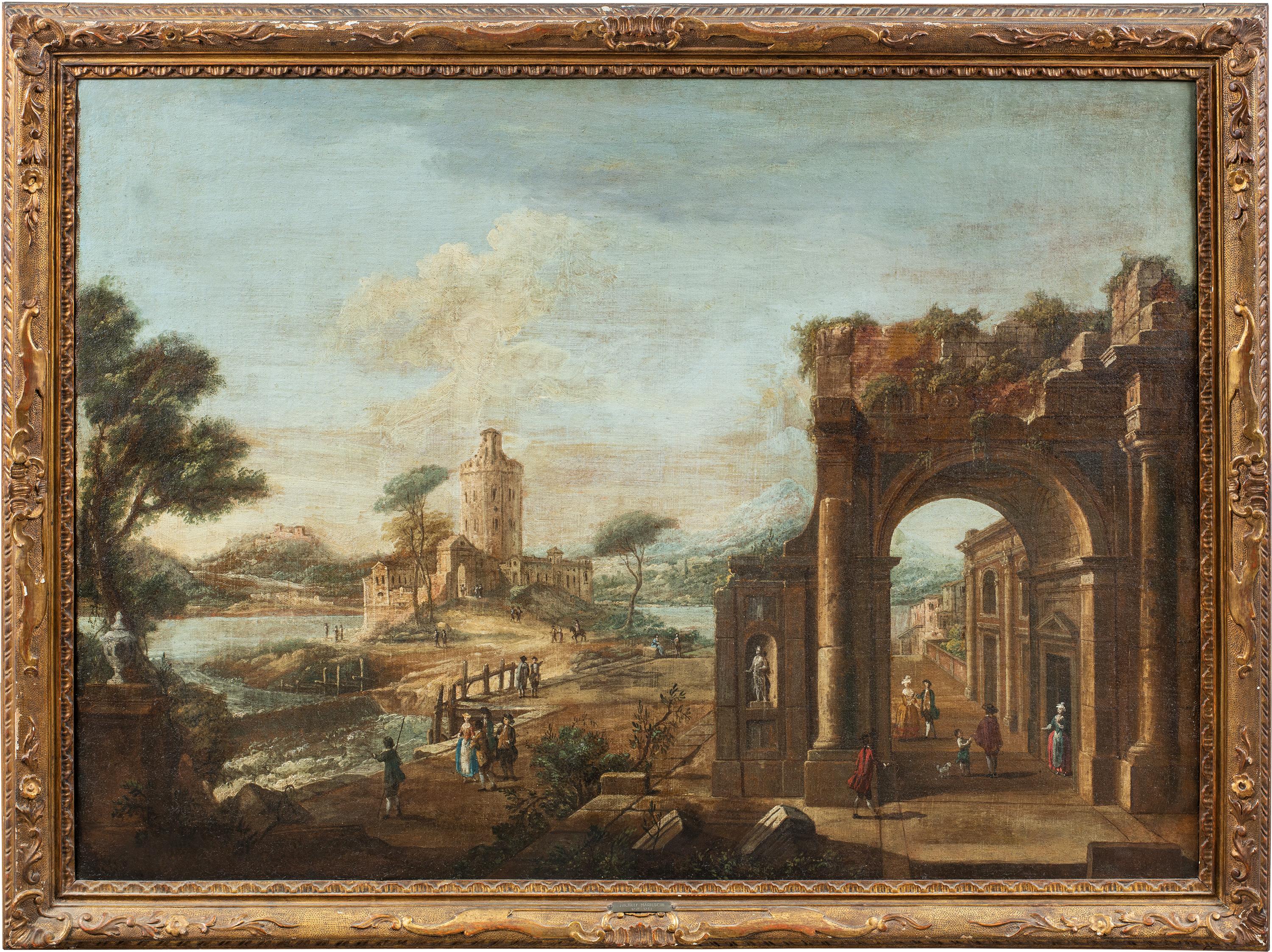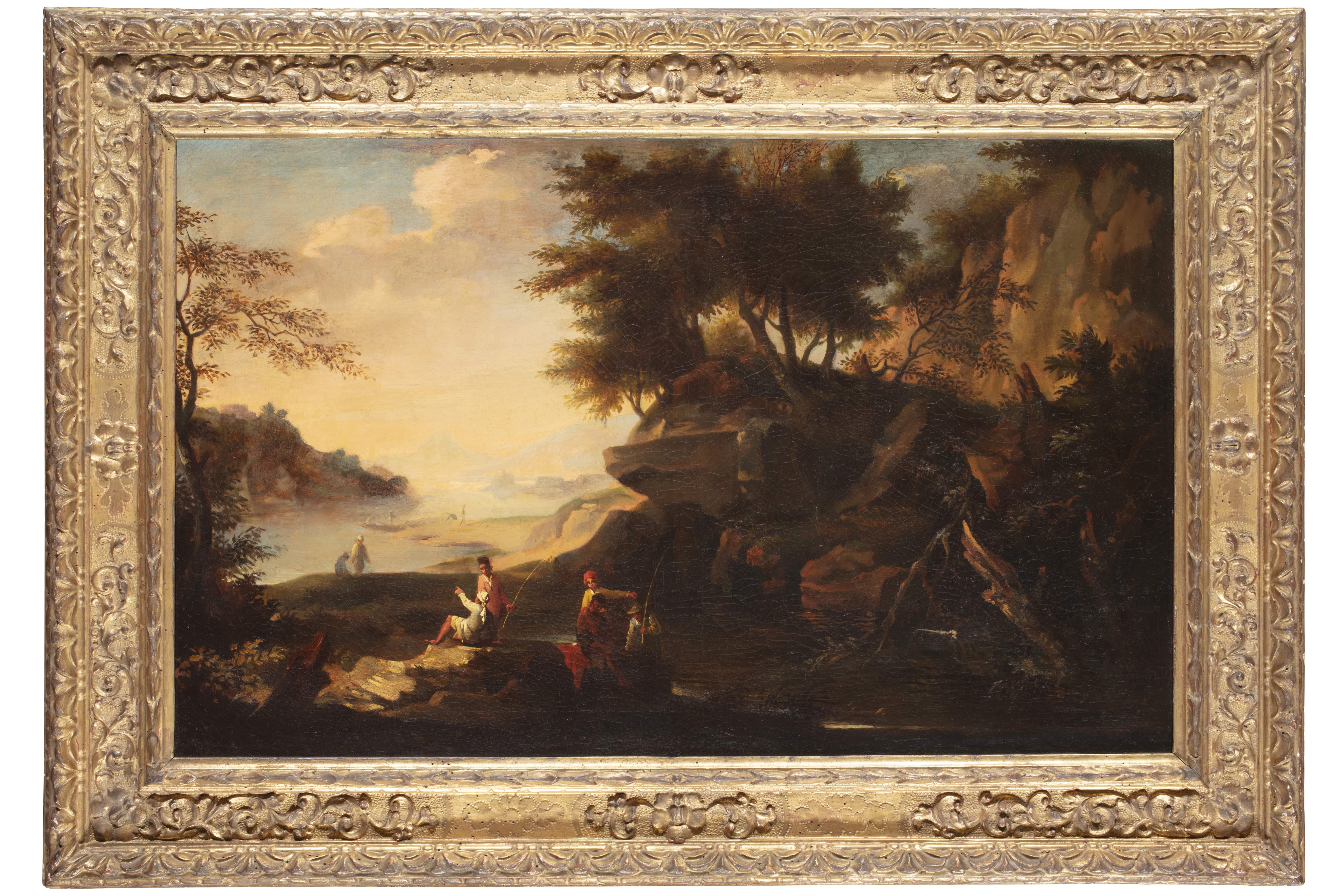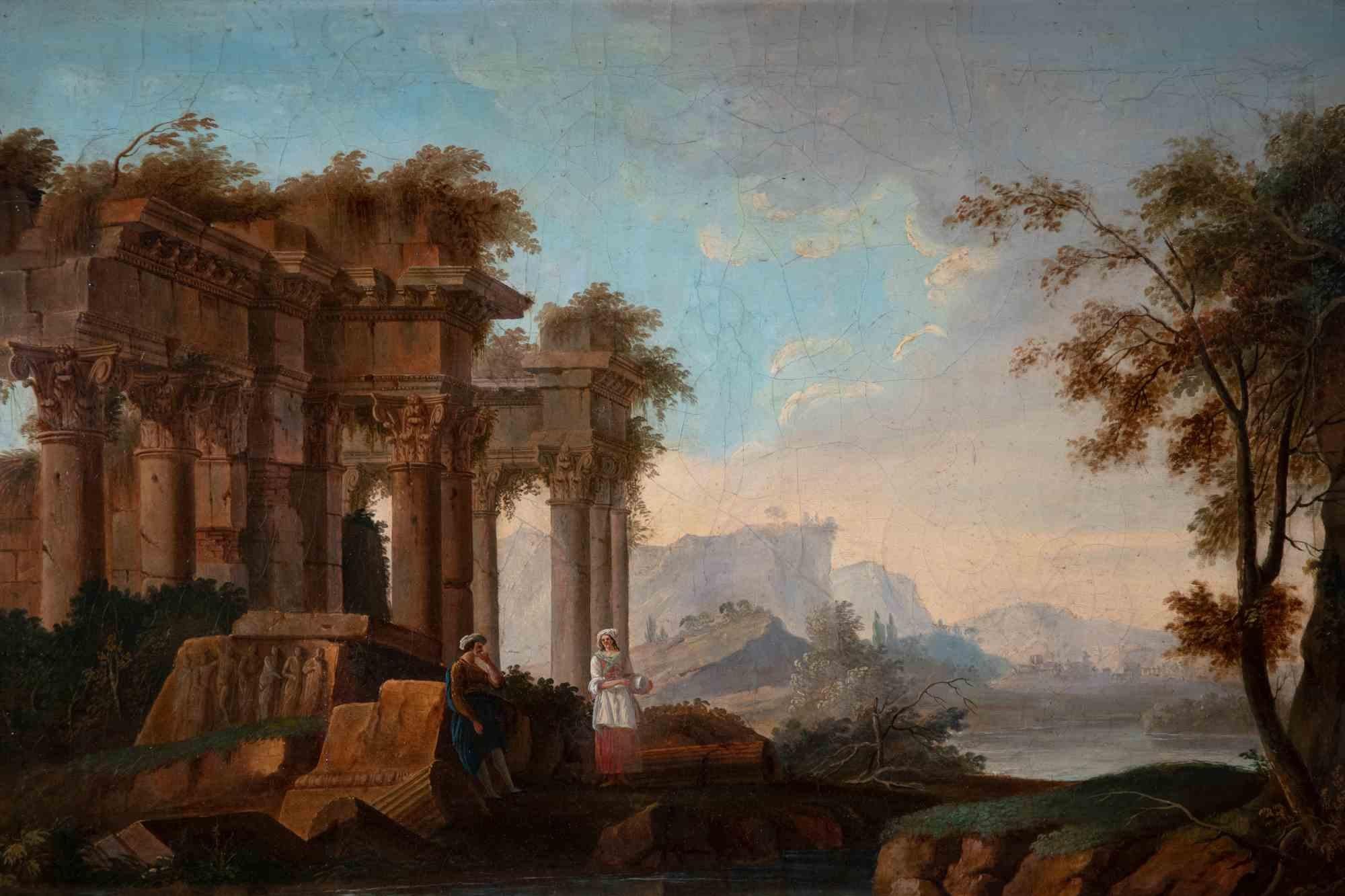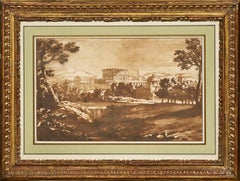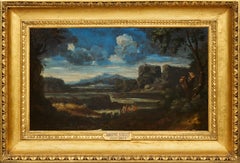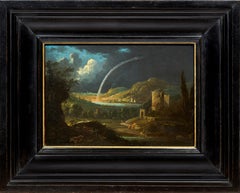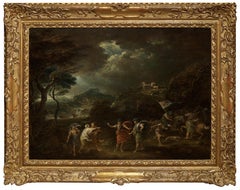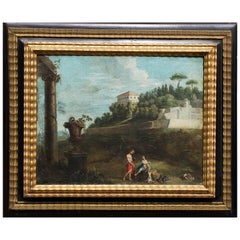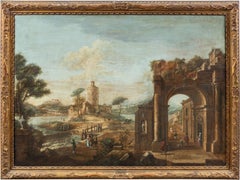Items Similar to Gathering in antique Ruins, a monogrammed painting by Jan van Haensbergen
Want more images or videos?
Request additional images or videos from the seller
1 of 10
Jan Van HaensbergenGathering in antique Ruins, a monogrammed painting by Jan van Haensbergen
$11,392.20
£8,474.65
€9,500
CA$15,599.82
A$17,344.87
CHF 9,056.54
MX$211,129.36
NOK 115,557.46
SEK 108,271.82
DKK 72,318.25
Shipping
Retrieving quote...The 1stDibs Promise:
Authenticity Guarantee,
Money-Back Guarantee,
24-Hour Cancellation
About the Item
Jan van Haensbergen was a painter of the Dutch Golden Age and a pupil of Cornelius van Poelenburgh (Utrecht 1594 - 1667). The painting we are presenting is inspired by Poelenburgh’s landscapes from his Italian sojourn. The dreamlike atmosphere of this Gathering in antique ruins appealed to us. Against a backdrop of antique ruins, three draped characters (perhaps bathers) are sitting in a circle, greeting a fourth character walking towards them.
Their tranquility contrasts with the bustle of the other characters in the background. They constitute a vivid illustration of otium, this leisure time that allows us to realize our full potential. With this Arcadian landscape, Jan van Haensbergen invites us in turn to leave the hustle and bustle of everyday life behind, to take a break, to enjoy the present moment chatting with close friends…
1. Jan van Haensbergen, a landscape and portrait painter of the Dutch Golden Age
Jan van Haensbergen was born in 1642 in Gorinchem, a town in southern Holland to the east of Rotterdam. He was a pupil of Cornelius van Poelenburgh, and began by painting landscapes inspired by those of his master, in an Italianate style. Between 1668 and 1669, he was registered at the Guild of Saint Luke in Utrecht.
In 1669, he moved to The Hague, where he joined the Confrérie Pictura, an artist society founded in 1656. His portraits, which became his main activity as a painter after settling in The Hague, were strongly influenced by Caspar Netscher (Prague or Heidelberg 1639 - The Hague 1684), whom he met in The Hague and whose son Constantijn became his son-in-law by marrying his daughter Magdalena.
In addition to his work as an artist, Van Haensbergen was also an art dealer, probably helped by his appointment as Dean of the Confrérie Pictura, where he also teached.
2. Description of the artwork and related paintings
This painting seems to us to be a kind of allegory of otium, that quiet bliss promised by Epicurus. It might even evoke an Epicurean proverb: "It is better to lie on the naked ground and be at ease, than to have a golden carriage and a rich table and be worried" .
Three draped young people - two men and a woman in the background - are seated in a circle, greeting a fourth figure walking towards them, hair disheveled and body draped in a towel as if drying off after a bath, indicating the need for prior purification to fully enjoy this rest. Their nonchalance contrasts with the bustle of the various characters in the background.
The composition is punctuated by successive diagonals, and opens onto a landscape on the right, with a succession of mountainous planes. This painting is typical of the Italianate works produced by Van Haensbergen in the 1660s under the influence of Cornelis van Poelenburgh (without ever visiting Italy himself). A comparison with the Bath of the Nymphs from the Mauritshuis in The Hague (last photo in the gallery), dated 1665, leads us to believe that our painting is probably a later one, as the composition appears to be more structured than the one of the Mauritshuis painting, revealing the work of a seasoned painter.
Another painting with a similar subject attributed to Jan van Haensbergen (and formerly to Cornelis van Poelenburgh) is held in the Royal Museums of Belgium.
3. Provenance and framing
This drawing comes from the personal collection of dealer and expert Paul Touzet (1898 - 1981). Between the wars, he opened his first gallery on rue de l'Université in Paris. He then moved to rue des Beaux-Arts, where he was exhibiting mainly Dutch and Flemish paintings. In the 1960s, his main activity became expertise during public auctions, and he remained one of the most renowned experts in Paris until his death in 1981.
To frame this painting, we have chosen an Italian gilded and painted wood frame from the 17th century. Its warm gilding echoes the ochre colors of our painting, while the black highlights evoke the Dutch frames.
- Creator:Jan Van Haensbergen (1642 - 1705)
- Dimensions:Height: 12.63 in (32.09 cm)Width: 14.63 in (37.17 cm)
- Medium:
- Movement & Style:
- Period:
- Condition:8 ½” x 10 7/8” (215 x 275 mm) – Framed : 12 5/8” x 14 5/8” (32 x 37.3 cm) Monogrammed lower center "IVH" Italian 17th century gilded and painted wood frame from Lebrun.
- Gallery Location:PARIS, FR
- Reference Number:1stDibs: LU1568214659632
About the Seller
5.0
Vetted Professional Seller
Every seller passes strict standards for authenticity and reliability
Established in 2020
1stDibs seller since 2021
10 sales on 1stDibs
Typical response time: 2 hours
- ShippingRetrieving quote...Shipping from: PARIS, France
- Return Policy
Authenticity Guarantee
In the unlikely event there’s an issue with an item’s authenticity, contact us within 1 year for a full refund. DetailsMoney-Back Guarantee
If your item is not as described, is damaged in transit, or does not arrive, contact us within 7 days for a full refund. Details24-Hour Cancellation
You have a 24-hour grace period in which to reconsider your purchase, with no questions asked.Vetted Professional Sellers
Our world-class sellers must adhere to strict standards for service and quality, maintaining the integrity of our listings.Price-Match Guarantee
If you find that a seller listed the same item for a lower price elsewhere, we’ll match it.Trusted Global Delivery
Our best-in-class carrier network provides specialized shipping options worldwide, including custom delivery.More From This Seller
View AllView of an Antique City, a wash landscape by Jan de Bisschop (1628 - 1671)
Located in PARIS, FR
The attribution to Jan de Bisschop has been confirmed by the RKD with the following comment: "We base this attribution on the dark washes, the subject represented and the monogram".
...
Category
17th Century Old Masters Landscape Drawings and Watercolors
Materials
Ink, Pen
Italian Landscape with Jack Players, a painting by Gaspard Dughet (1615 - 1675)
By Gaspard Dughet
Located in PARIS, FR
Here Gaspard Dughet offers us an idyllic vision of the Roman countryside. The stages follow one another in a perfectly structured composition, revealing here a lake, there travellers walking along, gradually leading our eye to the blue horizon. But behind its classical composition, this landscape is particularly interesting because of three anthropomorphic details that the artist has hidden, opening the way to a radically different interpretation...
1. Gaspard Dughet, a landscape artist in the light of Poussin
Gaspard Dughet was born on June 4th, 1615 in Rome where his father, of French origin, was a pastry cook. He was probably named Gaspard in honour of his godfather Baron Gaspard de Morant, who was, or may have been, his father's employer. His older sister Jeanne married the painter Nicolas Poussin (1594 - 1655) on September 1st, 1630. The young Gaspard was apprenticed with his brother-in-law at the beginning of 1631, which led his entourage to name him Gaspard Poussin. The first preserved works of the painter date from the years 1633-1634 and were painted in Poussin’s studio.
Around 1635, Gaspard Dughet became emancipated and began to frequent the Bamboccianti circle. In 1636, he became friends with the painter Jean Miel (1599 - 1656), but also with Pier Francesco Mola (1612 - 1666) and Pietro da Cortona (1596 - 1669).
This was also the time of his first trips throughout Italy. The painter, although of French origin, appears never to have visited France. In 1646 he settled permanently in Rome. A recognized painter with a solid book of orders, he remained faithful to landscape painting throughout his life, alternating between cabinet paintings and large decorative commissions, using both oil and fresco.
Nailed to his bed by rheumatic fever at the age of 58, he died on May 25, 1675.
2. Discovering an idealized landscape
Beyond a relatively dark foreground that takes us into the landscape, we discover a vast bluish horizon: a plateau surrounded by deep ravines advances to the right, overhanging an expanse of water that sparkles below. A road winds through a mountainous mass as if leading us to the fortress that crowns it; another town appears in the distance at the foot of three conical mountains.
The composition is rigorous, mineral, and structured by geometric volumes. The various stages in the landscape lead one to the next attracting the eye towards the horizon located in the middle of the canvas. The general impression is that of a welcoming and serene nature.
In many places the paint layer has shrunk, or become transparent, revealing the dark red preparation with which the canvas was covered and accentuating the contrasts.
Human presence is limited to three jack players, leaning against a mound in the foreground. Their long garments, which may evoke Roman togas, contribute to the timelessness of the scene.
Close examination of the canvas reveals two other travellers on the path winding between the rocks. Made tiny by the distance, their introduction in the middle register, typical of Dughet's art, lengthens the perspective.
While it is difficult to date the work of a painter who devoted his entire life to the representation of landscapes, it is certain that this painting is a work from his later years. The trees that occupied the foreground of his youthful compositions have been relegated to the sides, a stretch of water separates us from the arid mountains counterbalanced by two trees represented on the opposite bank. The introduction of this stretch of water in the middle of the landscape betrays the influence of the Bolognese and in particular of the Dominiquin (1581 - 1641)
A number of similarities with a drawing in the British Museum might suggest a date around 1656-1657, since, according to Marie-Nicole Boisclair , it has been compared with the Prado's Landscape with the Repentant Magdalene, painted at that period.
3. Three amazing anthropomorphic details
While some late Renaissance landscapes offer a radical double reading, allowing one to see both a face or a human body behind the representation of a landscape, it seems interesting to us to hypothesize that Gaspard Dughet had fun here by slipping in a few details that, taken in isolation, evoke human or animal figures.
We will give three examples, looking closely at a cloud, the trunk of a broken tree and the top of a cliff.
The main cloud could thus evoke a Christ-like face or that of an antique god...
Category
1650s Old Masters Landscape Paintings
Materials
Oil
River Landscape with Shepherds and Architecture, a painting by Jan van Bunnik
By Jan van Bunnik
Located in PARIS, FR
This painting has been the subject of a study by the art historian Fabrizio Dassie (available on request), confirming its inclusion in Jan van Bunnik’s corpus.
In this painting, Ja...
Category
Late 17th Century Old Masters Landscape Paintings
Materials
Copper
Macbeth and the Three Witches a Painting on Panel by Francesco Zuccarelli
By Francesco Zuccarelli
Located in PARIS, FR
This painting, created during Zuccarelli's stay in England, represents the decisive moment when Macbeth, together with Banquo, meets the three witches who announce that he will be Ki...
Category
1760s Old Masters Landscape Paintings
Materials
Oil, Wood Panel
Rocky Landscape with Trees and Temple Ruins a drawing by Giulio Parigi (ca 1615)
Located in PARIS, FR
This Rocky Landscape with Trees and the Ruins of a Temple is a drawing by Giulio Parigi, an eclectic and prolific artist of the Medici court. An engraver, architect, furniture and je...
Category
1610s Old Masters Landscape Drawings and Watercolors
Materials
Ink, Laid Paper, Pen
A landscape drawing by Claude Lorrain, with a preliminary sketch on the verso
By Claude Lorrain
Located in PARIS, FR
This study presents a typical Roman countryside landscape: an ancient mausoleum in front of which a cart is passing by followed by two peasants. If the technique (a pen drawing on graphite lines, completed with a wash of brown and grey inks) and the signature inevitably evoke the art of Lorrain, we find on the verso of this drawing additional evidences that lead us to consider this unpublished drawing as a work by the master.
The motif of the mausoleum has been taken up in pen on the verso in a technique that can be found in several other drawings by Lorrain. There is also a study of three characters, which can be considered as preparatory to Lorrain’s painting entitled The Port of Ostia with the Embarkation of Saint Paula, leading us to claim this attribution with a dating of around 1639.
1. Claude Lorrain or the perfection of classical landscape in Rome in the 17th century
Claude Gellée was born in 1600 in Chamagne in Lorraine. Orphaned at the age of twelve, he spent a year with his brother in Freiburg, where the latter was a woodcarver. Claude Gellée then probably arrived in Rome in 1613, where he joined the workshop of Agostino Tassi (1580 - 1644) in 1617. Between 1619 and 1620 he studied for two years in Naples in the workshop of Goffredi Wals (who was himself a former pupil of Tassi).
In 1625 he returned to Lorraine for two years where he worked alongside Claude Deruet. He then returned to Rome, a city he never left for the rest of his life (except for short trips to the surrounding countryside).
From 1627 to 1650 he lived in Via Margutta. From 1635 onwards he became a renowned painter and commissions started to pour in. Considered during his lifetime as the most accomplished of the classical landscape painters, his reputation never faded.
Between 1629 and 1635 Le Lorrain often went to the Roman countryside to draw with his friend Joachim von Sandrart (1606 - 1686). He became a member of the Academy of Saint Luke in 1633, while being closely acquainted with the Bentvueghels, this guild which brought together the young Nordic painters active in Rome. In 1643 he joined the Congregation of the Virtuosi. In 1650 he moved to Via Paolina where he lived until his death.
Little is known of his intimate life. He seems to have had a daughter, Agnes, from an ancillary love affair. In 1657/ 1658 she moved in with him. Stricken with gout in 1663, he died in 1682.
2. Description of the drawing; the technique of nature studies
Two peasants are walking behind a horse-drawn cart on a road that winds through ancient tombs. While a rectangular tomb with a columned facade can be seen in the distance, the cart passes an important ancient building. It has a circular shape and its partially ruined façade is decorated with columns. The start of a second floor can...
Category
1630s Old Masters Landscape Drawings and Watercolors
Materials
Pen, Graphite, Ink
You May Also Like
Travellers near Ruins in a Landscape - Dutch Old Master art figural oil painting
By Pieter Wouwerman
Located in London, GB
This lovely Dutch Old Master oil painting is attributed to artist Pieter Wouwerman. Painted circa 1660 it is figurative landscape with horseback travellers and their dogs in the foreground approaching ruins on their left. Beyond is a river snakes through the landscape, beneath the fading light of approaching dusk. There are some superb details making this an excellent Dutch Golden Age oil painting...
Category
Mid-17th Century Old Masters Landscape Paintings
Materials
Oil
Travellers and Dogs in Landscape, Ruins on Right - Dutch Old Master oil painting
By Pieter Wouwerman
Located in London, GB
This lovely Dutch Old Master oil painting is attributed to artist Pieter Wouwerman. Painted circa 1660 it is figurative landscape with horseback travellers and their dogs in the foreground with ruins on their right. Beyond is a river and hilly landscape, all in the fading light of approaching dusk. There are some superb details making this an excellent Dutch Golden Age oil painting.
Provenance: Devonshire estate.
Condition. Oil on canvas, 24 inches by 20 inches and in good condition.
Frame. Housed in a complementary gilt frame, 31 inches by 27 inches and in good condition.
Pieter Wouwerman (1623-1682) was a Dutch Golden Age landscape painter. He was born in Haarlem. According to Arnold Houbraken, a biographer of artists from the Dutch Golden Age, Pieter Wouwerman was the brother of the landscape painters Jan and Philips Wouwerman, who, like his more famous brother, made a living selling Italianate landscapes in the manner of Pieter van Laer...
Category
Mid-17th Century Old Masters Landscape Paintings
Materials
Oil
$17,550 Sale Price
20% Off
After Pieter van Bloemen Oil on Canvas Hunting & Ruins Scene
Located in Los Angeles, CA
School of Pieter van Bloemen (Flemish, 1657-1720) oil on Canvas "Hunting & Ruins Scene". The capriccio scene depicting two male hunters in robes, on...
Category
Antique 19th Century Belgian Renaissance Revival Paintings
Materials
Canvas, Wood, Giltwood
$5,850 Sale Price
38% Off
Francesco Battaglioli (Venetian master) - 18th century painting - Ruins Landscap
By Francesco Battaglioli
Located in Varmo, IT
Francesco Battaglioli (Modena 1710 ca. - Venice post 1796) - Architectural capriccio with characters.
83.5 x 114.5 cm without frame, 98 x 130 cm...
Category
Mid-18th Century Rococo Landscape Paintings
Materials
Canvas, Oil
17th Century by Jacob de Heusch Pair of Landscapes Oil on Canvas
Located in Milano, Lombardia
Jacob De Heusch (Utrecht, Netherlands, 1657 – Amsterdam, Netherlands, 1701)
Title: Pair of Landscapes
Medium: Oil on canvas
Dimensions: without frame 50 x 8...
Category
17th Century Old Masters Landscape Paintings
Materials
Oil, Canvas
Ancient Ruins - Oil Painting by Vinzenz Fischer - Late 18th Century
Located in Roma, IT
Ancient monuments is an original painting realized by Vinzenz Fischer (1729-1810) in the late 18th century.
Mixed colored oil painting on canvas.
This beautiful artwork represents ...
Category
Late 18th Century Figurative Paintings
Materials
Oil
More Ways To Browse
Antique Gatherings
Gilded Age Paintings
Jans Antiques
One Of A Kind Mens
Painting Of Naked Woman
Dutch Golden Age Painting
Italian Ruins Painting
Italy Ruins Painting
17th Century Dutch Landscape Paintings
Painting Dutch Town
Walking Table
17th Century Dutch Table
Royal Carriage
Arcadian Landscape
Antique Oil Portraits 17th Century
Antique Wood Plane
Antique Carriage Seat
Antique Settle Table


